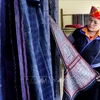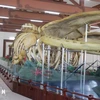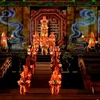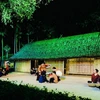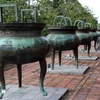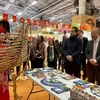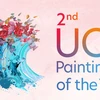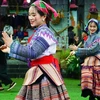The northern province of Bac Ninh is compiling a record of the making of Dong Ho folk woodcut painting to submit it to the UNESCO for its recognition.
This was revealed by Tran Van Tuy, Chairman of the People’s Committee of Bac Ninh, which has recently won the UNESCO’s recognition of its Quan Ho (duet singing) as an intangible cultural masterpiece of the humankind.
The making of Dong Ho folk woodcut painting was originated from Dong Ho village, Thuan Thanh district, Bac Ninh province.
Traditionally, Dong Ho painting, which reflected a wide range of themes, especially good luck wishes, historical figures, and folk allegories, was part of the essentials in each Vietnamese family during the traditional Tet (lunar New Year) festival.
According to the villagers, the making of Dong Ho painting was dated back to the 11th century during the reign of the Ly dynasty. However, researchers said the craft began under the rule of the Le dynasty.
Making the painting, Dong Ho craftsmen used raw materials from nature, including making sheets of printing papers from bark of “do” tree and creating colours from earth, burnt bamboo leaves, sea shell.
Printing the picture, they used the woodblock which is applied with paint and pressed it on a sheet of paper like a stamp. The process was repeated with different colours until the craftsman felt satisfied with the painting.
The finished painting was later covered with a layer of rice paste to strengthen the durability of its illustration and colours and afterwards dried under the sun.
As the traditional craft has faded with time, efforts have been made to preserve it, with Nguyễn Đăng Chế, one of the few remaining experienced craftsmen of the village establishing his own Dong Ho painting centre in 2008./.
This was revealed by Tran Van Tuy, Chairman of the People’s Committee of Bac Ninh, which has recently won the UNESCO’s recognition of its Quan Ho (duet singing) as an intangible cultural masterpiece of the humankind.
The making of Dong Ho folk woodcut painting was originated from Dong Ho village, Thuan Thanh district, Bac Ninh province.
Traditionally, Dong Ho painting, which reflected a wide range of themes, especially good luck wishes, historical figures, and folk allegories, was part of the essentials in each Vietnamese family during the traditional Tet (lunar New Year) festival.
According to the villagers, the making of Dong Ho painting was dated back to the 11th century during the reign of the Ly dynasty. However, researchers said the craft began under the rule of the Le dynasty.
Making the painting, Dong Ho craftsmen used raw materials from nature, including making sheets of printing papers from bark of “do” tree and creating colours from earth, burnt bamboo leaves, sea shell.
Printing the picture, they used the woodblock which is applied with paint and pressed it on a sheet of paper like a stamp. The process was repeated with different colours until the craftsman felt satisfied with the painting.
The finished painting was later covered with a layer of rice paste to strengthen the durability of its illustration and colours and afterwards dried under the sun.
As the traditional craft has faded with time, efforts have been made to preserve it, with Nguyễn Đăng Chế, one of the few remaining experienced craftsmen of the village establishing his own Dong Ho painting centre in 2008./.


